 |
|
Tucson International Airport |
| Tucson International Airport |
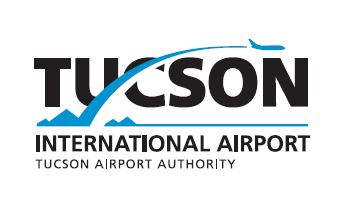 |
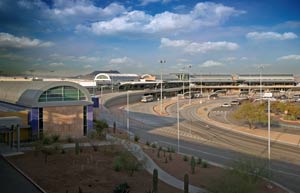 |
| IATA: TUS – ICAO: KTUS – FAA LID: TUS
Location of the Tucson International Airport
|
| Summary |
| Airport type |
Public |
| Owner |
Tucson Airport Authority |
| Serves |
Tucson, Arizona |
| Location |
South Tucson, Arizona |
| Elevation AMSL |
2,643 ft / 806 m |
| Coordinates |
32°06′58″N 110°56′28″W / 32.11611°N 110.94111°W / 32.11611; -110.94111 |
| Website |
www.tucsonairport.org |
| Runways |
| Direction |
Length |
Surface |
| ft |
m |
| 3/21 |
7,000 |
2,134 |
Asphalt |
| 11L/29R |
10,996 |
3,352 |
Asphalt |
| 11R/29L |
8,408 |
2,563 |
Asphalt |
| Statistics (2007) |
| Aircraft operations |
251,099 |
| Passenger boardings |
2,223,008 |
| Passenger arrivals/departures |
4,429,905 |
| Source: FAA and airport website |
Tucson International Airport (IATA: TUS, ICAO: KTUS, FAA LID: TUS) is a joint civil-military public airport located six miles (10 km) south of the central business district of Tucson, in Pima County, Arizona, United States, and is the second largest and busiest airport in Arizona, after Sky Harbor International Airport in Phoenix. Overview
Tucson International is owned and operated by the Tucson Airport Authority, which also operates Ryan Airfield.
Currently, Tucson International Airport is not a hub or focus city for any major passenger airline.
The airport recently completed a Concourse Renovation Project, the last phase of an extensive remodeling begun in 2000 that added 82,000 sq ft (7,600 m) to ticketing and baggage claim. On March 19, 2008, the previous West/East concourses and gates were renumbered with the East Concourse becoming Concourse A: Gates A1 - A9, and the West Concourse becoming Concourse B: Gates B1 - B11. The international arrival area was relocated to the main terminal in Concourse A, whereas before it existed in a separate terminal.
Public transportation to and from the airport is provided by Sun Tran bus routes #6 and #11.
History
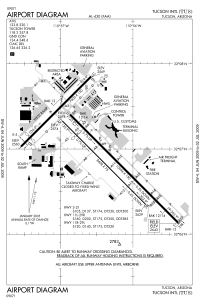 | |
FAA diagram of Tucson International Airport
|
In 1919, Tucson opened the first municipally owned airport in the United States. Nine years later, in 1928, commercial air service began at Tucson International with Standard Airlines (later American Airlines) in 1928. Regular airmail service started two years later.
During World War II, the airfield was used by the United States Army Air Force Air Technical Service Command. A contract flying school was also operated by the USAAF West Coast Training Center from 25 July 1942 until September 1944.
In 1948, the Tucson Airport Authority was created as a non-profit corporation to operate the airport. The airport was then moved to its current location and operated on the west ramp out of three hangars vacated by World War II military manufacturing companies.
In 1963, a new terminal facility was completed, housing six airlines and an international inspection station, earning the title, Tucson International Airport.
Airfield
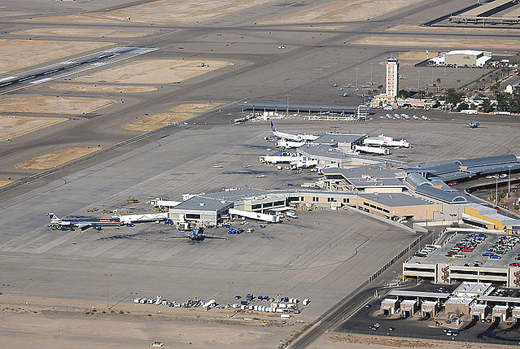 | |
Aerial view of Tucson International Airport
|
Tucson International Airport covers an area of 8,244 acres (33 km) and contains three runways:
- Runway 11L/29R: 10,996 x 150 ft (3,352 x 46 m), air carrier runway, ILS equipped.
- Runway 11R/29L: 8,408 x 75 ft (2,563 x 23 m), air carrier runway, general aviation, & air taxi.
- Runway 3/21: 7,000 x 150 ft (2,134 x 46 m), air carrier runway, general aviation & air taxi.
For the 12-month period ending December 31, 2007, the airport had 257,191 aircraft operations, an average of 704 per day: 59% general aviation, 17% scheduled commercial, 14% military and 10% air taxi.
Runway 11L is used the most for commercial air traffic, as there are often prevailing winds, and it is preferred. In occasional trade winds, commercial traffic uses runway 29R, and even rarer, with strong winds from the south, runway 21. Runway 11R-29L is too narrow (only 75 ft. wide) for most commercial aircraft, but runway 3 can be used by commercial flights.
Statistics
In 2008, the airport had 2,116,694 enplanements and 2,109,175 deplanements, a decrease of 4.61% from calendar year 2007. In 2007, airline seat capacity was down by apx 1,500 to 6,741 compared to 8,180 seats in 2007 as a result of reductions by the airlines in response to the spike in oil prices.
In 2007, Tucson International Airport set a new passenger record for the fourth consecutive year with 4,429,905 total arriving and departing passengers, an increase of 4.8% over the 2006 total. Tucson's top ranked carriers included Southwest Airlines, with a 30% market share; American Airlines, which accounted for 19.6% of the total traffic, and US Airways which had a 12.5% market share.
Terminals and Concourses
Tucson International Airport is split into two concourses, Concourse A which contains 9 gates: A1 - A9, and Concourse B which contains 11 gates: B1 - B11. As of July 2009, Tucson's eight carriers serve 15 destinations.
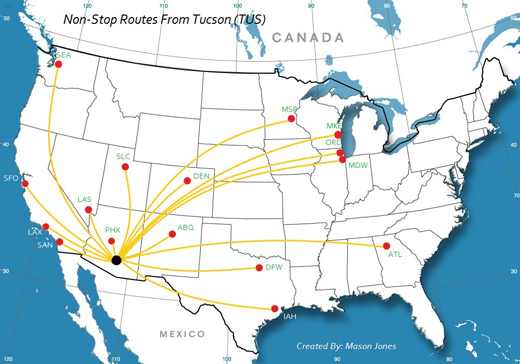 | |
Destinations with nonstop service from Tucson
|
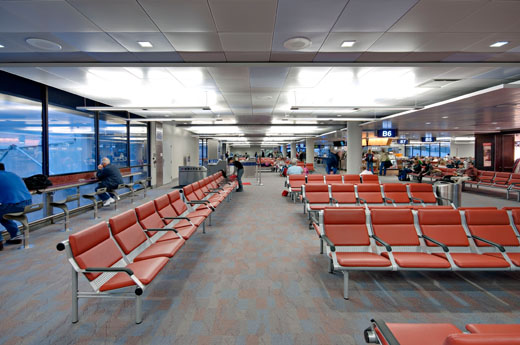 | |
Departure Gate B6
|
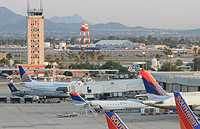 | |
Southwest is currently Tucson's largest carrier offering 18 daily flights to 6 cities.
|
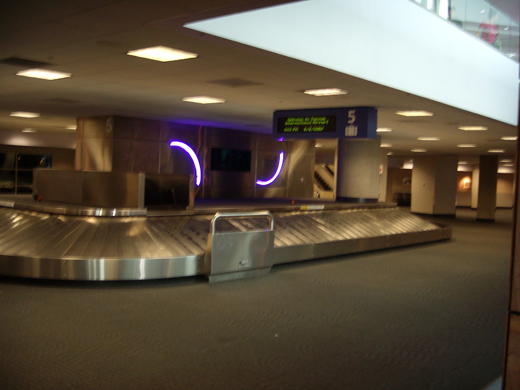 | |
The Baggage Claim area at Tucson International Airport. Baggage Claim Belt 5, is used by Southwest Airlines exclusively.
|
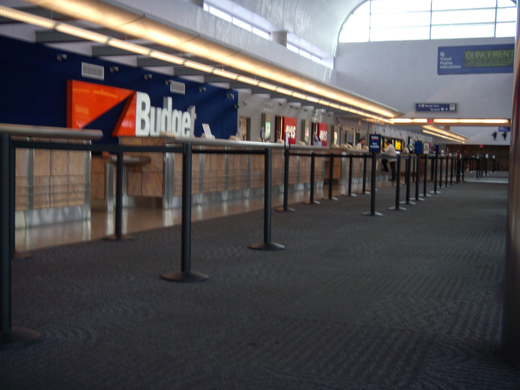 | |
The Rental Car Complex at Tucson International Airport (north end to south end). TIA is serviced by all seven major rental car compaines.
|
International Terminal
Note: All international arrivals and departures are handled in the Main Terminal.
U.S. Customs and Immigration have offices located in a separate building within walking distance of the Main Terminal (the International Terminal). This is the reason TUS is still designated as an international airport despite currently having no scheduled passenger flights that leave the United States. There is one daily international cargo flight, to Hermosillo, Mexico. Aeroméxico used to fly from Tucson to Mexico City and Guadalajara, as the only international airline there, but ceased all Tucson operations in February of 2008.
Main Terminal
All ticketing occurs at the ticketing level and all baggage claim is located at the baggage level. The terminal's third level contains a full service restaurant as well as public meeting rooms available for rent.
Concourse A
Concourse A has 9 Gates: A1 - A9
Concourse B
Concourse B has 11 Gates: B1 - B11
Airlines and destinations
| Airlines |
Destinations |
Concourse |
| Alaska Airlines |
Seattle/Tacoma |
B |
| American Airlines |
Chicago-O'Hare, Dallas/Fort Worth |
A |
| Continental Express operated by ExpressJet Airlines |
Houston-Intercontinental |
B |
| Delta Air Lines |
Atlanta
Seasonal: Minneapolis/St. Paul |
B |
Delta Connection operated by
SkyWest Airlines |
Salt Lake City |
B |
| Frontier Airlines |
Denver |
A |
| Frontier Airlines operated by Republic Airlines |
Denver
Seasonal: Milwaukee [begins January 8] |
A |
| Southwest Airlines |
Albuquerque, Chicago-Midway, Denver, Las Vegas, Los Angeles, San Diego |
A |
United Express operated by
SkyWest Airlines |
Denver, Los Angeles, San Francisco |
B |
| US Airways |
Phoenix |
B |
| US Airways Express operated by Mesa Airlines |
Phoenix |
B |
Cargo Terminal
There are two air freight facilities located east of the Main Terminal, off Airport Drive. Air carriers providing air freight include:
- ABX Air
- Air Cargo Transit
- Cargo Force Inc.
- EGL-Eagle Global Logistics
- FedEx Express
- Matheson Flight Extenders Inc.
- UPS Airlines
Military Facilities
Tucson International Airport also hosts Tucson Air National Guard Base, a 92-acre complex on the northwest corner of the airport that is home to the 162d Fighter Wing (162 FW), an Air Education and Training Command (AETC)-gained unit of the Arizona Air National Guard. The largest Air National Guard fighter unit in the United States, the 162 FW operates over 70 F-16C/D/E/F aircraft in three operational fighter squadrons. The wing provides training on the F-16 Fighting Falcon, augmenting the active Air Force's 56th Fighter Wing (56 FW) at Luke AFB, Arizona as a Formal Training Unit (FTU) for training Regular Air Force, Air Force Reserve Command, Air National Guard and NATO/Allied/Coalition F-16 pilots.
The wing also hosts the Air National Guard / Air Force Reserve Command (ANG AFRC) Command Test Center as a tenant unit, which conducts operational testing on behalf of the Air Reserve Component. The 162 FW also hosts "Snowbird" operations during the winter months for Air Force, Air Force Reserve Command, and Air National Guard F-16 and A-10 units from northern tier bases in the continental United States, as well as Canadian Forces and Royal Air Force flying units.
During its history at TUS, the 162nd has operated the F-86 Sabre, F-100 Super Sabre, F-102 Delta Dagger, A-7 Corsair II and F-16 Fighting Falcon aircraft. Not counting students or transient flight crews, the installation employs over 1,700 personnel, over 1,100 of whom are full-time Active Guard and Reserve (AGR) and Air Reserve Technician (ART) personnel, and the remainder traditional part-time Air National Guardsmen. Although an AETC organization, the 162nd also maintains an F-16 Alert Detachment at nearby Davis-Monthan AFB in support of Operation Noble Eagle.
The above content comes from Wikipedia and is published under free licenses – click here to read more.
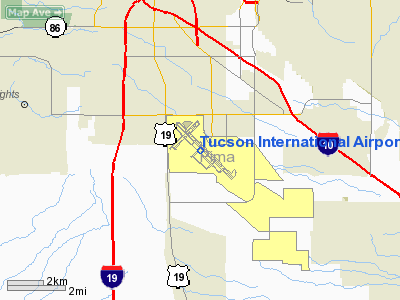
Ryan Airfield is a general aviation reliever airport located
12 miles west of Tucson International Airport at the intersection of Ajo
Way and Valencia Road. The field was created in the 1940s as a training
camp for the Army Air Corps.
After the war, the state of Arizona approached the Tucson
Airport Authority, who also manages Tucson International, about operating
the airfield. The Authority and the state entered into a long-term lease
agreement and over the years Ryan Airfield has become a busy and popular
airfield.
Passenger Statistics (Year
2004)
Passenger Arrivals/Departures: 3,770,445
Aircraft Operations: 253,616
Daily Departures: 72 average
Daily Seats: 6,939
Facilities
TIA covers 8,244 acres
Latitude 32�, 7 min
Longitude 110�, 56 min
Elevation 2641' MSL
Terminal has 26 aircraft parking spaces, plus two spaces at International
Building.
Long term parking - 917 spaces. Short term - 422 spaces.
Park 'N Save
- 5,645 spaces.
U.S. Port of Entry with 24-hour Customs and Immigration service.
Privately owned hangars house 240 aircraft; TAA and its tenants offer tie
down positions for another 350 general aviation aircraft.
Runways:
11L/29R -10,994' x 150'
11R/29L - 9,129' x 75'
3/21 - 7,000' x 150'
Economic Impact
- The airport employs nearly 13,000 people with a payroll
of $72 million.
- It is estimated there are another 10,000 people working
in the airport area.
- $136 million is spent on local goods and services.
- The combined economic impact of aviation related activity
on local payrolls and expenditures is $941,730,657 or nearly $1 billion.
Commercial Service
- 11 Airlines provide service: AeroCalifornia, Aerolitoral,
Alaska, American, America West, Continental, Delta/SkyWest, Frontier,
Northwest, Southwest, United.
- Nonstop Destinations: Albuquerque, Atlanta, Chicago,
Dallas, Denver, Houston, Las Vegas, Los Angeles, Minneapolis, Phoenix,
Salt Lake City, San Diego, Seattle, Hermosillo Mexico and connections
to more than 121 destinations.
- Top 10 Origination and Destination Markets: Atlanta,
Los Angeles, Las Vegas, San Diego, Denver, Chicago, Seattle, Dallas,
Salt Lake City, Washington D.C.
- There are appx. 67 daily flights with approximately
6,600 seats available.
History
- Tucson opened the first municipally owned airport in
the United States in 1919.
- Commercial air service began in Tucson with Standard
Airlines (later American Airlines) in 1928. Regular airmail service
started two years later.
- In 1948 the Tucson Airport Authority was created as
a non-profit corporation to operate the airport.
- The airport moved to its current location and operated
on the west ramp out of three hangars vacated by WWII military manufacturing
companies.
- In 1963 a new terminal facility was completed, housing
six airlines and an international inspection station, earning the title,
Tucson International Airport.
Directions
From Downtown and U of A: Take Campbell Ave., which turns into Kino Parkway
south of Broadway. Follow road signs to Benson Highway, which leads to Tucson
Blvd. and the airport entrance.
From East Side: Take Kolb Rd. south to Valencia. Travel west on Valencia
to Tucson Blvd., turn south to airport entrance.
From Midtown: Take Alvernon south to where it merges with Palo Verde. Continue
south on Palo Verde to Valencia. Travel west on Valencia to Tucson Blvd.,
turn south to airport entrance.
From South: Take I-19 north to Valencia. Exit on eastbound Valencia and
continue east to Tucson Blvd., turn south to airport entrance.
From Northwest: Take I-10 east to South Kino Parkway exit. Follow road signs,
which lead to Tucson Blvd. and the airport entrance.
Location & QuickFacts
|
FAA
Information Effective: |
2005-10-27 |
|
Airport Identifier: |
TUS |
|
Longitude/Latitude: |
110-56-27.7000W/32-06-57.9000N
-110.941028/32.116083 (Estimated) |
|
Elevation: |
2643 ft / 805.59 m (Surveyed) |
|
Land: |
7938 acres |
|
From nearest city: |
6
nautical miles S of Tucson, AZ |
|
Location: |
Pima County, AZ |
|
Magnetic Variation: |
12E (1995) |
Owner & Manager
|
Ownership: |
Publicly owned |
|
Owner: |
Tucson Airport Authority
AS AGENT FOR CITY OF TUCSON. |
|
Address: |
Tucson Apt Auth 7005 S Plumer
Tucson, AZ 85706 |
|
Phone number: |
520-573-8100 |
|
Manager: |
Bonnie Allin
AIRPORT OPERATIONS DATA CONTACT LIISA FEDERICO. |
|
Address: |
Tucson Apt Auth 7005 S Plumer
Tucson, AZ 85706 |
|
Phone number: |
520-573-8100 |
Airport Operations and Facilities
|
Airport
Use: |
Open to public |
|
Wind indicator: |
Yes |
|
Segmented Circle: |
No |
|
Control Tower: |
Yes |
|
Attendance Schedule: |
ALL/ALL/ALL |
|
Lighting Schedule: |
DUSK-DAWN
REIL RY 29L & RY 29R DALGT HRS ONLY. |
|
Beacon Color: |
Clear-Green (lighted land airport) |
|
Landing fee charge: |
Yes |
|
Sectional chart: |
Phoenix |
|
Region: |
AWP - Western-Pacific |
|
Traffic Pattern
Alt: |
800 ft |
|
Boundary ARTCC: |
ZAB - Albuquerque |
|
Tie-in FSS: |
PRC - Prescott |
|
FSS on Airport: |
No |
|
FSS Phone: |
928-778-7810 |
|
FSS Toll Free: |
1-800-WX-BRIEF |
|
NOTAMs Facility: |
TUS (NOTAM-d service avaliable) |
|
Certification type/date: |
DS 5/1973 |
|
Federal Agreements: |
NGPSY3 |
Airport Communications
Airport Services
|
Fuel
available: |
100LLA |
|
Airframe
Repair: |
MAJOR |
|
Power
Plant Repair: |
MAJOR |
|
Bottled Oxygen: |
HIGH/LOW |
|
Bulk Oxygen: |
HIGH/LOW |
Runway Information
Runway 03/21
|
Dimension: |
7000
x 150 ft / 2133.6 x 45.7 m |
|
Surface: |
ASPH,
Good Condition |
|
Surface Treatment: |
Saw-cut
or plastic Grooved |
|
Weight Limit: |
Single
wheel: 105000 lbs.
Dual wheel: 137000 lbs.
Dual tandem wheel: 230000 lbs.
Dual dual tandem wheel: 500000 lbs.
FAA GWT EVALUATION DC-10-10 300000 LBS; DC-10-30/40 375000 LBS;
L-1011-1 310000 LBS & L-1011-100/200 315000 LBS.
FAA GWT EVALUATION DC-10-10 315000 LBS; DC-10-30/40 400000 LBS;
L-1011-1 325000 LBS & L-1011-100/200 340000 LBS. |
|
Edge Lights: |
Medium |
|
|
Runway 03 |
Runway 21 |
|
Longitude: |
110-57-32.5458W |
110-56-34.9560W |
|
Latitude: |
32-07-01.8014N |
32-07-50.7384N |
|
Elevation: |
2560.00 ft |
2569.00 ft |
|
Alignment: |
45 |
127 |
|
Traffic Pattern: |
Left |
Right |
|
Markings: |
Basic, Good Condition |
Basic, Good Condition |
|
Arresting: |
|
MA1A |
|
Crossing Height: |
0.00 ft |
50.00 ft |
|
Displaced threshold: |
841.00 ft |
0.00 ft |
|
VASI: |
|
4-box on left side |
|
Visual Glide Angle: |
0.00� |
3.00� |
|
Runway End Identifier: |
|
Yes |
|
Touchdown Lights: |
No |
No |
|
Obstruction: |
21
ft rr, 270.0 ft from runway, 250 ft left of centerline, 3:1
slope to clear
APCH RATIO 50:1 TO DSPLCD THR. |
40
ft , 1400.0 ft from runway, 300 ft right of centerline, 30:1
slope to clear |
|
Runway 11L/29R
|
Dimension: |
10996
x 150 ft / 3351.6 x 45.7 m |
|
Surface: |
ASPH,
Good Condition |
|
Surface Treatment: |
Saw-cut
or plastic Grooved |
|
Weight Limit: |
Single
wheel: 160000 lbs.
Dual wheel: 200000 lbs.
Dual tandem wheel: 350000 lbs.
Dual dual tandem wheel: 585000 lbs.
FAA GWT EVALUATION DC-10-10 300000 LBS; DC-10-30/40 375000 LBS;
L-1011-1 310000 LBS & L-1011-100/200 315000 LBS.
FAA GWT EVALUATION DC-10-10 315000 LBS; DC-10-30/40 400000 LBS;
L-1011-1 325000 LBS & L-1011-100/200 340000 LBS. |
|
Edge Lights: |
High |
|
|
Runway 11L |
Runway 29R |
|
Longitude: |
110-56-52.4830W |
110-55-22.1457W |
|
Latitude: |
32-07-24.1303N |
32-06-07.1649N |
|
Elevation: |
2578.00 ft |
2643.00 ft |
|
Alignment: |
127 |
127 |
|
ILS Type: |
ILS |
|
|
Traffic Pattern: |
Left |
Left |
|
Markings: |
Precision instrument, Good Condition |
Non-precision instrument, |
|
Arresting: |
BAK12B |
BAK9 |
|
Crossing Height: |
55.00 ft |
0.00 ft |
|
VASI: |
4-light PAPI on left side |
6-box on left side
VASI RWY 29R UPWND TCH 94' GLIDE ANGLE 3.25 DEG; DWNWND TCH
50' GLIDE ANGLE 3.00 DEG. |
|
Visual Glide Angle: |
3.00� |
0.00� |
|
Approach lights: |
MALSR |
|
|
Runway End Identifier: |
|
Yes |
|
Touchdown Lights: |
No |
No |
|
Obstruction: |
,
50:1 slope to clear |
8
ft gnd, 400.0 ft from runway, 500 ft right of centerline,
25:1 slope to clear |
|
Runway 11R/29L
|
Dimension: |
8408
x 75 ft / 2562.8 x 22.9 m |
|
Surface: |
ASPH,
Good Condition |
|
Weight Limit: |
Single
wheel: 120000 lbs.
Dual wheel: 140000 lbs.
Dual tandem wheel: 220000 lbs.
FAA GWT EVALUATION DC-10-10 300000 LBS; DC-10-30/40 375000 LBS;
L-1011-1 310000 LBS & L-1011-100/200 315000 LBS.
FAA GWT EVALUATION DC-10-10 315000 LBS; DC-10-30/40 400000 LBS;
L-1011-1 325000 LBS & L-1011-100/200 340000 LBS. |
|
Edge Lights: |
Medium |
|
|
Runway 11R |
Runway 29L |
|
Longitude: |
110-56-58.7458W |
110-55-49.6585W |
|
Latitude: |
32-07-19.5716N |
32-06-20.7192N |
|
Elevation: |
2574.00 ft |
2629.00 ft |
|
Alignment: |
127 |
127 |
|
Traffic Pattern: |
Right |
Left |
|
Markings: |
Basic, Good Condition |
Basic, Good Condition |
|
Displaced threshold: |
1410.00 ft |
0.00 ft |
|
VASI: |
4-light PAPI on left side |
|
|
Visual Glide Angle: |
3.00� |
0.00� |
|
Runway End Identifier: |
|
Yes |
|
Touchdown Lights: |
No |
No |
|
Obstruction: |
,
50:1 slope to clear |
37
ft pole, 1400.0 ft from runway, 350 ft left of centerline,
32:1 slope to clear |
|
Radio Navigation Aids
|
ID |
Type |
Name |
Ch |
Freq |
Var |
Dist |
|
RYN |
NDB |
Ryan |
|
338.00 |
12E |
11.3
nm |
|
RBJ |
NDB |
Robles |
|
220.00 |
12E |
21.5
nm |
|
AVQ |
NDB |
Marana |
|
245.00 |
12E |
22.6
nm |
|
ENZ |
NDB |
Nogales |
|
394.00 |
12E |
42.0
nm |
|
DAO |
NDB |
Dragoo |
|
410.00 |
13E |
44.1
nm |
|
DMA |
TACAN |
Davis
Monthan |
123X |
|
12E |
4.0
nm |
|
ARH |
TACAN |
Fort
Huachuca |
053X |
|
12E |
44.3
nm |
|
FHU |
VOR |
Libby |
|
113.60 |
13E |
43.6
nm |
|
OLS |
VOR/DME |
Nogales |
019X |
108.20 |
12E |
42.4
nm |
|
TUS |
VORTAC |
Tucson |
107X |
116.00 |
12E |
1.8
nm |
Remarks
-
<
STARTING TO PRIOR AGL 400? LEAST AT ATTAIN REQD 11R RWY DEPG>
-
B747 ACFT TAXI WITH
INBOARD ENGINES ONLY.
-
TWY C FROM TWY A5 TO
A8 AND FROM TWY A8 TO A13 CLSD TO FIXED WING AIRCRAFT.
-
TWY A11 NORTH OF RY
11L/29R CLSD TO ALL MILITARY FIGHTER ACFT.
-
PORTIONS OF TWY D NOT
VISIBLE FROM ATCT DUE TO HANGARS.
-
TWY T - GENERAL AVIATION
TWY, 30,000 LBS OR LESS.
-
RY 11L/29R HAS DSTC
REMAINING MKS ON NE SIDE. RY 03/21 HAS DSTC REMAINING MKRS ON SE SIDE.
-
NO B-747 TRNG EXCP PPR;
NO FLT TRNG 2200-0600 EXCP PPR; CALL FLIGHTLINE OFFICE 520-573-8128.
-
(E60-26R) A-GEAR LCTD
1200 FT WEST OF APCH END OF RY.
-
RY 11R/29L LNDG AND
DEP RESTRICTED TO ACFT LESS THAN 184,000 LBS GWT AND B727 ENGINE CONFIGURATION.
Based Aircraft
|
Aircraft
based on field: |
376 |
|
Single Engine Airplanes: |
188 |
|
Multi Engine Airplanes: |
24 |
|
Jet Engine Airplanes: |
62 |
|
Helicopters: |
34 |
|
Military: |
68 |
Major Carriers Serving This
Airport
| Sky
West Airlines |
27.8% |
|
Southwest Airlines |
27.4% |
|
American Airlines |
21.3% |
| United
Airlines |
5.6% |
| Delta
Air Lines |
5.5% |
|
Continental Airlines |
4.9% |
|
Continental Express Airlines |
3.2% |
|
Northwest Airlines |
2.5% |
| Alaska
Airlines |
1.8% |
Most Popular Destinations
|
Los
Angeles Intl (LAX) |
20.1% |
|
Dallas/fort
Worth International (DFW) |
14.3% |
|
Salt
Lake City Intl (SLC) |
12.6% |
|
Mc
Carran Intl (LAS) |
9.0% |
|
Chicago
O'hare Intl (ORD) |
9.0% |
|
George
Bush Intercontinental/houston (IAH) |
7.7% |
|
Denver
Intl (DEN) |
6.1% |
|
San
Diego Intl (SAN) |
5.6% |
|
Hartsfield
- Jackson Atlanta Intl (ATL) |
5.5% |
|
Albuquerque
Intl Sunport (ABQ) |
3.6% |
Most Popular Aircraft
|
N698BR |
0.6% |
|
N905SW |
0.4% |
|
N923SW |
0.4% |
|
N925SW |
0.4% |
|
N955SW |
0.4% |
|
N973SW |
0.4% |
|
N937SW |
0.3% |
|
N920SW |
0.3% |
|
N936SW |
0.3% |
|
N455SW |
0.3% |
Operational Statistics
|
Aircraft
Operations: |
804/Day |
|
Air Carrier: |
13.6% |
|
Air Taxi: |
6.2% |
|
General Aviation
Local: |
26.1% |
|
General Aviation
Itinerant: |
24.3% |
|
Military: |
16.3% |
Tucson International Airport
Contact Us:
Tucson Airport Authority
7005 S. Plumer Ave.
Tucson, AZ 85706
Telephone: 520-573-8100
Fax: 520-573-8008
E-mail:
info@tucsonairport.org
URL: http://www.tucsonairport.org/
|
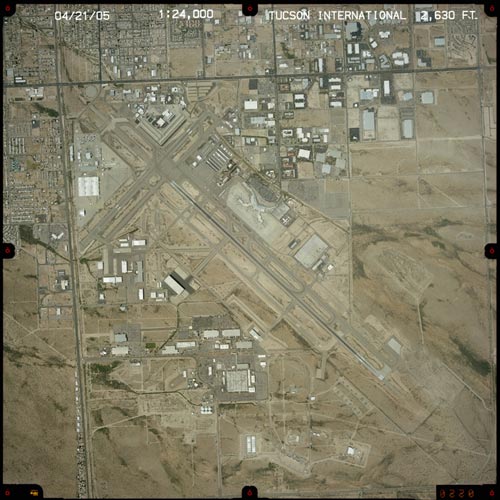 |
(Click on the photo to
enlarge) |
|
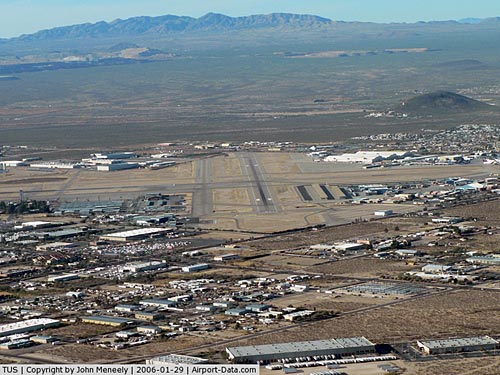 |
(Click on the photo to
enlarge) |
Images and information placed above are from
http://www.airport-data.com/airport/TUS/
http://www.dot.state.az.us/aviation/airports/airports_list.asp?FAA=TUS
http://www.tucsonairport.org/index.html
We thank them for the data!
| General
Info |
| Country |
United
States |
| State |
ARIZONA
|
| FAA ID |
TUS |
| Latitude |
32-06-57.900N
|
| Longitude |
110-56-27.700W
|
| Elevation |
2643 feet
|
| Near City |
TUCSON
|
We don't guarantee the information is fresh and accurate. The data may be wrong or outdated.
For more up-to-date information please refer to other sources.
|
 |



